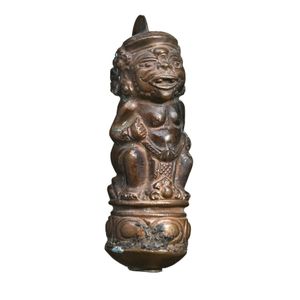Carved Qing Dynasty Timber Brushpot
You must be a subscriber, and be logged in to view price and dealer details.
Subscribe Now to view actual auction price for this item
When you subscribe, you have the option of setting the currency in which to display prices to $Au, $US, $NZ or Stg.
- Chinese Ding Porcelain - Ding ware is a type of Chinese porcelain that was produced in the northern city of Ding in the Hebei province during the Song Dynasty (960-1279). It is considered to be one of the "Five Great Kilns" of Chinese ceramics, along with Jian, Jun, Guan, and Ru wares.
Ding ware is known for its fine white porcelain body, which was made from kaolin clay, and its elegant shapes and designs. The glaze on Ding ware is usually transparent and has a bluish-white or grayish-white color. It was often decorated with underglaze blue or iron-brown designs.
Ding ware was highly prized during the Song Dynasty, and it was exported throughout Asia and as far as the Middle East and the Mediterranean. It was also an inspiration for other porcelain-making centers in China and Japan. The production of Ding ware declined after the Song Dynasty, and it is now considered to be a rare and valuable collectible. - Faceting - Faceting is a technique of removing material from a curved surface, to give a series of flat surfaces but retaining the profile of the original surface.
The technique is most commonly associated with diamond cutting where the various cuts used such as rose cut and brilliant cut, add life and sparkle to the stone, whilst at the same time removing as little of the stone as possible.
Faceting by grinding is also used to decorate glass. The stems of many drinking glasses are decorated by cutting a series of flat surfaces on a circular stem, and hollow vessels such as vases may have faceted surfaces.
In furniture faceting is often applied to legs of tables and chairs, where a circular baluster shaped section is flattened so as to form an octagonal section. - Incised - A record of a name, date or inscription, or a decoration scratched into a surface, usually of a glass or ceramic item with a blunt instrument to make a coarse indentation. Compare with engraving where the surface is cut with a sharp instrument such as a metal needle or rotating tool to achieve a fine indentation.
- Qing Dynasty - The Qing Dynasty was the last imperial dynasty of China, ruling from 1644 to 1912. It was established by the Manchu people, who originated from the northeastern region of China. The Qing Dynasty was preceded by the Ming Dynasty and followed by the Republic of China.
- Ming Dynasty - The Ming Dynasty was a ruling dynasty of China from 1368 to 1644. It succeeded the Yuan Dynasty and preceded the Qing Dynasty. The Ming Dynasty was established by Zhu Yuanzhang, a former Buddhist monk who became a rebel leader and eventually overthrew the Mongol Yuan Dynasty. During the Ming Dynasty, China experienced a period of relative stability and prosperity. The government was centralized and bureaucratic, with the emperor at the top of the hierarchy. The Ming Dynasty is known for its cultural achievements, including the development of porcelain, the invention of movable type printing, and the construction of the Great Wall of China.
This item has been included into following indexes:
Visually similar items

A pair of 17th century oak torcheres carved as rampant lions, with polychrome remnants, 74 cm high

Ivory carved dog of Fo stamp seal with one pup under her right paw & another pup on the back of her head. She is sitting on a plain round base, the impressed seal carved into the base. C1800 height 9.5 cm

Bali, handle, copper modelled in the form of a Parekan figure, 10.5 cm height

Hook Figure. Standing figure with raised decoration, inlaid shell eyes, Dry patina with traces of pigment. Papua New Guinea. Length 130 cm. Width 27 cm. Provenance: T. Clemence Collection, New Zealand
